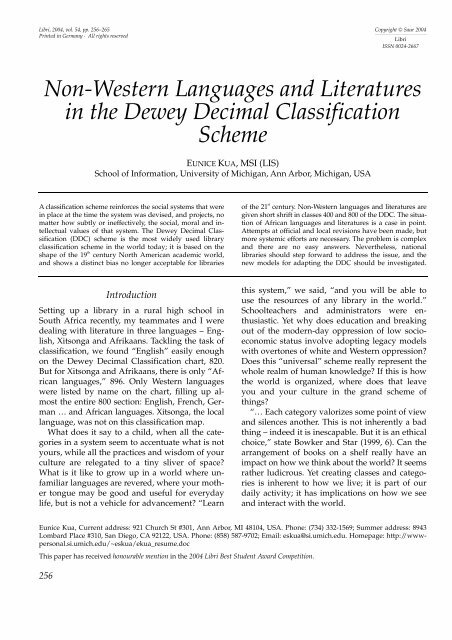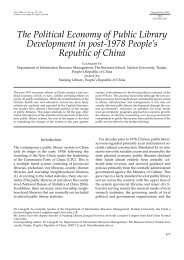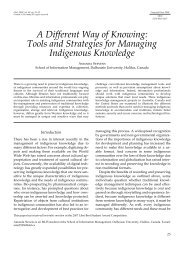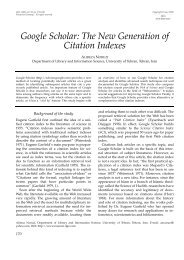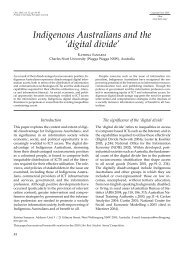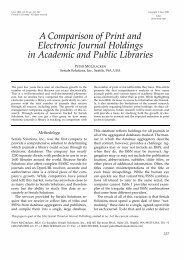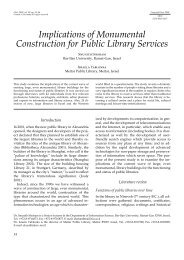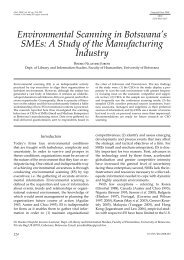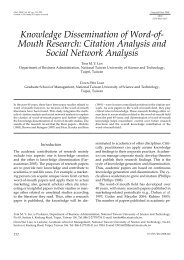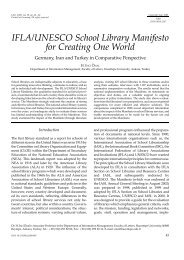Non-Western Languages and Literatures in the Dewey Decimal - Libri
Non-Western Languages and Literatures in the Dewey Decimal - Libri
Non-Western Languages and Literatures in the Dewey Decimal - Libri
Create successful ePaper yourself
Turn your PDF publications into a flip-book with our unique Google optimized e-Paper software.
<strong>Libri</strong>, 2004, vol. 54, pp. 256–265<br />
Pr<strong>in</strong>ted <strong>in</strong> Germany · All rights reserved<br />
Copyright © Saur 2004<br />
______________________________________________<br />
<strong>Libri</strong><br />
ISSN 0024-2667<br />
<strong>Non</strong>-<strong>Western</strong> <strong>Languages</strong> <strong>and</strong> <strong>Literatures</strong><br />
<strong>in</strong> <strong>the</strong> <strong>Dewey</strong> <strong>Decimal</strong> Classification<br />
Scheme<br />
EUNICE KUA, MSI (LIS)<br />
School of Information, University of Michigan, Ann Arbor, Michigan, USA<br />
A classification scheme re<strong>in</strong>forces <strong>the</strong> social systems that were<br />
<strong>in</strong> place at <strong>the</strong> time <strong>the</strong> system was devised, <strong>and</strong> projects, no<br />
matter how subtly or <strong>in</strong>effectively, <strong>the</strong> social, moral <strong>and</strong> <strong>in</strong>tellectual<br />
values of that system. The <strong>Dewey</strong> <strong>Decimal</strong> Classification<br />
(DDC) scheme is <strong>the</strong> most widely used library<br />
classification scheme <strong>in</strong> <strong>the</strong> world today; it is based on <strong>the</strong><br />
shape of <strong>the</strong> 19 th<br />
century North American academic world,<br />
<strong>and</strong> shows a dist<strong>in</strong>ct bias no longer acceptable for libraries<br />
of <strong>the</strong> 21 st century. <strong>Non</strong>-<strong>Western</strong> languages <strong>and</strong> literatures are<br />
given short shrift <strong>in</strong> classes 400 <strong>and</strong> 800 of <strong>the</strong> DDC. The situation<br />
of African languages <strong>and</strong> literatures is a case <strong>in</strong> po<strong>in</strong>t.<br />
Attempts at official <strong>and</strong> local revisions have been made, but<br />
more systemic efforts are necessary. The problem is complex<br />
<strong>and</strong> <strong>the</strong>re are no easy answers. Never<strong>the</strong>less, national<br />
libraries should step forward to address <strong>the</strong> issue, <strong>and</strong> <strong>the</strong><br />
new models for adapt<strong>in</strong>g <strong>the</strong> DDC should be <strong>in</strong>vestigated.<br />
Introduction<br />
Sett<strong>in</strong>g up a library <strong>in</strong> a rural high school <strong>in</strong><br />
South Africa recently, my teammates <strong>and</strong> I were<br />
deal<strong>in</strong>g with literature <strong>in</strong> three languages – English,<br />
Xitsonga <strong>and</strong> Afrikaans. Tackl<strong>in</strong>g <strong>the</strong> task of<br />
classification, we found “English” easily enough<br />
on <strong>the</strong> <strong>Dewey</strong> <strong>Decimal</strong> Classification chart, 820.<br />
But for Xitsonga <strong>and</strong> Afrikaans, <strong>the</strong>re is only “African<br />
languages,” 896. Only <strong>Western</strong> languages<br />
were listed by name on <strong>the</strong> chart, fill<strong>in</strong>g up almost<br />
<strong>the</strong> entire 800 section: English, French, German<br />
… <strong>and</strong> African languages. Xitsonga, <strong>the</strong> local<br />
language, was not on this classification map.<br />
What does it say to a child, when all <strong>the</strong> categories<br />
<strong>in</strong> a system seem to accentuate what is not<br />
yours, while all <strong>the</strong> practices <strong>and</strong> wisdom of your<br />
culture are relegated to a t<strong>in</strong>y sliver of space?<br />
What is it like to grow up <strong>in</strong> a world where unfamiliar<br />
languages are revered, where your mo<strong>the</strong>r<br />
tongue may be good <strong>and</strong> useful for everyday<br />
life, but is not a vehicle for advancement? “Learn<br />
this system,” we said, “<strong>and</strong> you will be able to<br />
use <strong>the</strong> resources of any library <strong>in</strong> <strong>the</strong> world.”<br />
Schoolteachers <strong>and</strong> adm<strong>in</strong>istrators were enthusiastic.<br />
Yet why does education <strong>and</strong> break<strong>in</strong>g<br />
out of <strong>the</strong> modern-day oppression of low socioeconomic<br />
status <strong>in</strong>volve adopt<strong>in</strong>g legacy models<br />
with overtones of white <strong>and</strong> <strong>Western</strong> oppression?<br />
Does this “universal” scheme really represent <strong>the</strong><br />
whole realm of human knowledge? If this is how<br />
<strong>the</strong> world is organized, where does that leave<br />
you <strong>and</strong> your culture <strong>in</strong> <strong>the</strong> gr<strong>and</strong> scheme of<br />
th<strong>in</strong>gs?<br />
“… Each category valorizes some po<strong>in</strong>t of view<br />
<strong>and</strong> silences ano<strong>the</strong>r. This is not <strong>in</strong>herently a bad<br />
th<strong>in</strong>g – <strong>in</strong>deed it is <strong>in</strong>escapable. But it is an ethical<br />
choice,” state Bowker <strong>and</strong> Star (1999, 6). Can <strong>the</strong><br />
arrangement of books on a shelf really have an<br />
impact on how we th<strong>in</strong>k about <strong>the</strong> world? It seems<br />
ra<strong>the</strong>r ludicrous. Yet creat<strong>in</strong>g classes <strong>and</strong> categories<br />
is <strong>in</strong>herent to how we live; it is part of our<br />
daily activity; it has implications on how we see<br />
<strong>and</strong> <strong>in</strong>teract with <strong>the</strong> world.<br />
Eunice Kua, Current address: 921 Church St #301, Ann Arbor, MI 48104, USA. Phone: (734) 332-1569; Summer address: 8943<br />
Lombard Place #310, San Diego, CA 92122, USA. Phone: (858) 587-9702; Email: eskua@si.umich.edu. Homepage: http://wwwpersonal.si.umich.edu/~eskua/ekua_resume.doc<br />
This paper has received honourable mention <strong>in</strong> <strong>the</strong> 2004 <strong>Libri</strong> Best Student Award Competition.<br />
256
<strong>Non</strong>-<strong>Western</strong> languages <strong>and</strong> literatures <strong>in</strong> <strong>the</strong> <strong>Dewey</strong> <strong>Decimal</strong> Classification scheme<br />
A classification scheme re<strong>in</strong>forces <strong>the</strong> social<br />
systems that were <strong>in</strong> place at <strong>the</strong> time <strong>the</strong> system<br />
was devised, <strong>and</strong> projects, no matter how subtly<br />
or <strong>in</strong>effectively, <strong>the</strong> social, moral <strong>and</strong> <strong>in</strong>tellectual<br />
values of that system. How we arrange books on<br />
a shelf both reflects <strong>and</strong> shapes our perceptions<br />
about <strong>the</strong> proper order of th<strong>in</strong>gs. How an <strong>in</strong>dividual<br />
collection is arranged may have few repercussions.<br />
However, when an organization<br />
scheme is used <strong>in</strong> 200,000 libraries <strong>in</strong> 135 countries<br />
<strong>and</strong> over 30 languages (OCLC, 1), <strong>the</strong>re is<br />
cause for concern.<br />
This paper will focus on <strong>the</strong> treatment of non-<br />
<strong>Western</strong> language <strong>and</strong> literature <strong>in</strong> <strong>the</strong> <strong>Dewey</strong><br />
<strong>Decimal</strong> Classification (DDC) system. After a<br />
brief overview of <strong>the</strong> DDC, it discusses classes<br />
400 <strong>and</strong> 800 – language <strong>and</strong> literature, respectively,<br />
identifies biases <strong>in</strong>herent <strong>in</strong> each, <strong>and</strong> gives <strong>the</strong><br />
case example of <strong>the</strong> language <strong>and</strong> literature of<br />
Africa. It <strong>the</strong>n reviews efforts to revise <strong>the</strong> DDC<br />
<strong>and</strong> offers reflections on what needs to be done<br />
<strong>and</strong> what obstacles are <strong>in</strong> <strong>the</strong> way. The paper<br />
concludes with recommendations toward more<br />
equitable treatment of languages <strong>and</strong> literature <strong>in</strong><br />
<strong>the</strong> DDC.<br />
The DDC <strong>in</strong> context<br />
The <strong>Dewey</strong> <strong>Decimal</strong> Classification system was<br />
<strong>the</strong> 19 th<br />
century bra<strong>in</strong>child of Melvil <strong>Dewey</strong>, an<br />
energetic library <strong>and</strong> education reformer <strong>and</strong><br />
bus<strong>in</strong>essman. Build<strong>in</strong>g on a scheme devised by<br />
Francis Bacon <strong>in</strong> medieval times <strong>and</strong> adapted <strong>in</strong><br />
<strong>the</strong> 19 th century by St. Louis Public Schools super<strong>in</strong>tendent<br />
William T. Harris for use <strong>in</strong> a school library,<br />
<strong>Dewey</strong>, at <strong>the</strong> age of 21, came up with a system<br />
that was simple to use <strong>and</strong> widely adopted<br />
by <strong>the</strong> emerg<strong>in</strong>g public libraries of his day (Shera,<br />
77–84; Wieg<strong>and</strong>, 176–177, 190; OCLC). His scheme<br />
operated on basic assumptions of classical <strong>Western</strong><br />
thought, i.e., a belief <strong>in</strong> a universal order of<br />
nature <strong>and</strong> a fixed, hierarchical organization of<br />
knowledge (Shera, 78; Drabenstott 2003). More<br />
specifically, accord<strong>in</strong>g to Wieg<strong>and</strong> (1998), <strong>Dewey</strong>’s<br />
categories were crafted on <strong>the</strong> basis of <strong>the</strong> Amherst<br />
College curriculum, textbooks <strong>and</strong> faculty<br />
op<strong>in</strong>ions of <strong>the</strong> time. Olson (2000) has analyzed<br />
<strong>and</strong> shown how <strong>the</strong> DDC classes correspond to<br />
trends <strong>in</strong> <strong>Western</strong> philosophy. It is, thus, a def<strong>in</strong>ite<br />
<strong>Western</strong> classical-Anglo Saxon Protestant scholarly<br />
worldview of a particular era (Wieg<strong>and</strong> 1998)<br />
that <strong>in</strong>formed <strong>the</strong> decisions that set <strong>the</strong> classes<br />
<strong>and</strong> sub-classes <strong>in</strong> place.<br />
The DDC today is <strong>the</strong> most widely used classification<br />
scheme <strong>in</strong> <strong>the</strong> world (IFLA 2003). As alluded<br />
to earlier, it appears <strong>in</strong> 135 countries, with<br />
translations complete or <strong>in</strong> progress <strong>in</strong> over 30 languages,<br />
<strong>in</strong>clud<strong>in</strong>g Arabic, Ch<strong>in</strong>ese, French, German,<br />
Greek, Hebrew, Icel<strong>and</strong>ic, Italian, Korean,<br />
Norwegian, Russian, Spanish <strong>and</strong> Vietnamese<br />
(OCLC). Available <strong>in</strong> pr<strong>in</strong>t <strong>and</strong> on <strong>the</strong> Web, it is<br />
considered by some to be “arguably <strong>the</strong> most important<br />
bibliographic classification scheme” (Rowley,<br />
201), <strong>and</strong> “as an <strong>in</strong>ternational classification,<br />
… probably <strong>the</strong> most pragmatic, efficient, <strong>and</strong><br />
economical choice” (Durlik 2002), due to its relative<br />
simplicity, its extensive adoption by public<br />
<strong>and</strong> school libraries, <strong>and</strong> its cont<strong>in</strong>ued revision<br />
<strong>and</strong> upkeep.<br />
Yet <strong>the</strong> system is problematic even <strong>in</strong> its core<br />
structure. Divid<strong>in</strong>g <strong>the</strong> entire universe of knowledge<br />
<strong>in</strong>to ten ma<strong>in</strong> classes is an audacious proposition,<br />
<strong>and</strong> try<strong>in</strong>g to fit everyth<strong>in</strong>g that has<br />
ever been written <strong>in</strong>to those 10 classes is ra<strong>the</strong>r<br />
<strong>in</strong>credible (see Figure 1, Appendix, for <strong>the</strong> ten<br />
classes). The ma<strong>in</strong> classes, fur<strong>the</strong>rmore, are arranged<br />
not by subject, but by academic discipl<strong>in</strong>e<br />
(<strong>Dewey</strong> for W<strong>in</strong>dows 1998, quoted <strong>in</strong> Olson). The<br />
entire system is based on <strong>the</strong> shape of <strong>the</strong> 19 th century<br />
North American academic world, <strong>and</strong> what<br />
paths scholars chose to <strong>in</strong>vestigate <strong>and</strong> acquire<br />
knowledge <strong>the</strong>n. Not only has <strong>the</strong> shape of <strong>the</strong><br />
scholarly world changed s<strong>in</strong>ce <strong>the</strong>n (<strong>and</strong> thus Philosophy<br />
<strong>and</strong> Psychology, for example, no longer<br />
seem to go toge<strong>the</strong>r), but <strong>the</strong> balance <strong>and</strong> volume<br />
of material on different topics have also shifted<br />
(Rowley 1996, 202).<br />
In addition, classes such as Language (400) are<br />
located far away from Literature (800); Technology<br />
(600) conta<strong>in</strong>s many overlapp<strong>in</strong>g concerns with<br />
Science (500); Build<strong>in</strong>gs (690) is removed from<br />
Architecture (720) (Rowley 1996, 202). These designations<br />
appear to be artifacts of <strong>the</strong> Baconian<br />
th<strong>in</strong>k<strong>in</strong>g on which <strong>the</strong> scheme is based (Olson<br />
2000, 117); <strong>the</strong> order <strong>and</strong> contents of <strong>the</strong> classes,<br />
removed from <strong>the</strong> underly<strong>in</strong>g thought structure<br />
(expla<strong>in</strong>ed <strong>in</strong> Scott 1998, 13), can seem whimsical<br />
<strong>and</strong> counter-<strong>in</strong>tuitive to <strong>the</strong> modern user.<br />
The DDC is owned by <strong>the</strong> OCLC Onl<strong>in</strong>e<br />
Computer Library Center <strong>in</strong> Dubl<strong>in</strong>, Ohio, <strong>and</strong><br />
ma<strong>in</strong>ta<strong>in</strong>ed <strong>and</strong> updated by <strong>the</strong> U.S. Library of<br />
Congress <strong>Decimal</strong> Classification Division. It is<br />
257
Eunice Kua<br />
Figure 2. Subclasses with<strong>in</strong> class 400 Language <strong>and</strong> class 800<br />
Literature<br />
400 Language<br />
410 L<strong>in</strong>guistics<br />
420 English & Old English<br />
430 German & related<br />
languages<br />
440 French & related<br />
languages<br />
450 Italian, Romanian &<br />
related languages<br />
460 Spanish & Portuguese<br />
languages<br />
470 Lat<strong>in</strong> & Italic languages<br />
480 Classical & modern Greek<br />
languages<br />
490 O<strong>the</strong>r languages<br />
Source: Web<strong>Dewey</strong> (DDC 22)<br />
<strong>in</strong> its 22 nd<br />
“DDC 22.”<br />
800 Literature, rhetoric &<br />
criticism<br />
810 American literature <strong>in</strong><br />
English<br />
820 English & Old English<br />
literatures<br />
830 German & related<br />
literatures<br />
840 French & related<br />
literatures<br />
850 Italian, Romanian &<br />
related literatures<br />
860 Spanish & Portuguese<br />
literatures<br />
870 Lat<strong>in</strong> & Italic literatures<br />
880 Classical & modern Greek<br />
literatures<br />
890 O<strong>the</strong>r literatures<br />
edition, affectionately known as<br />
DDC Classes 400 <strong>and</strong> 800<br />
DDC Class 400 is for Language, <strong>and</strong> class 800 is<br />
for Literature. The follow<strong>in</strong>g figure shows <strong>the</strong> subclasses<br />
(hundreds) with<strong>in</strong> each of <strong>the</strong>se classes.<br />
Class 400 represents <strong>the</strong> discipl<strong>in</strong>e of l<strong>in</strong>guistics.<br />
The first subclass (400) is used for general<br />
works on philosophy <strong>and</strong> <strong>the</strong>ory of language.<br />
The second subclass (410) is used for L<strong>in</strong>guistics,<br />
“… <strong>the</strong> structure of spoken <strong>and</strong> written language<br />
<strong>in</strong> general” (Scott, p. 110). The next seven subclasses,<br />
420–480, are devoted to <strong>the</strong> study of specific<br />
European languages, mostly from <strong>Western</strong><br />
Europe. The f<strong>in</strong>al subclass, 490, holds all <strong>the</strong><br />
world’s o<strong>the</strong>r languages, <strong>in</strong>clud<strong>in</strong>g African, Asian,<br />
Oceanic, Semitic <strong>and</strong> Native American languages.<br />
Thus, while an entire subclass is devoted to<br />
French (440 French, 441 French writ<strong>in</strong>g systems,<br />
442 French etymology, 448 St<strong>and</strong>ard French usage),<br />
Ch<strong>in</strong>ese, <strong>the</strong> world’s most widely spoken<br />
language (about 900 million speakers (Turner,<br />
2001)), starts at 495.1, i.e., three subdivisions deeper<br />
<strong>in</strong> <strong>the</strong> hierarchy (490 O<strong>the</strong>r languages, 495 East<br />
<strong>and</strong> Sou<strong>the</strong>ast Asian languages, 495.1 Ch<strong>in</strong>ese).<br />
French grammar is assigned <strong>the</strong> base number 445;<br />
Ch<strong>in</strong>ese grammar starts at 495.15. In fact, of <strong>the</strong><br />
world’s 10 most widely spoken languages, only<br />
four are <strong>in</strong> <strong>the</strong> 420–480 range (English, Spanish,<br />
Portuguese <strong>and</strong> German). The rest are located <strong>in</strong><br />
Figure 3. <strong>Languages</strong> <strong>in</strong> subclasses 490 <strong>and</strong> 890<br />
490 O<strong>the</strong>r <strong>Languages</strong><br />
491 East Indo-European &<br />
Celtic languages<br />
492 Afro-Asiatic languages,<br />
Semitic languages<br />
493 <strong>Non</strong>-Semitic Afro-Asiatic<br />
languages<br />
494 Altaic, Uralic, Hyperborean<br />
& Dravidian<br />
languages<br />
495 <strong>Languages</strong> of East &<br />
Sou<strong>the</strong>ast Asia, S<strong>in</strong>o-<br />
Tibetan languages<br />
496 African languages<br />
497 North American native<br />
languages<br />
498 South American native<br />
languages<br />
499 <strong>Non</strong>-Austronesian<br />
languages of Oceania,<br />
Austronesian languages,<br />
miscellaneous languages<br />
Source: Web<strong>Dewey</strong> (DDC 22)<br />
890 <strong>Literatures</strong> of o<strong>the</strong>r<br />
languages<br />
891 East Indo-European &<br />
Celtic literatures<br />
892 Afro-Asiatic languages,<br />
Semitic literatures<br />
893 <strong>Non</strong>-Semitic Afro-Asiatic<br />
literatures<br />
894 Altaic, Uralic, Hyperborean<br />
& Dravidian<br />
literatures<br />
895 <strong>Languages</strong> of East &<br />
Sou<strong>the</strong>ast Asia, S<strong>in</strong>o-<br />
Tibetan literatures<br />
896 African literatures<br />
897 North American native<br />
literatures<br />
898 South American native<br />
literatures<br />
899 <strong>Non</strong>-Austronesian<br />
literatures of Oceania,<br />
Austronesian literatures,<br />
miscellaneous literatures<br />
490, i.e., Bengali, H<strong>in</strong>di/Urdu, Arabic, Russian<br />
<strong>and</strong> Japanese (Turner 2001).<br />
There is obviously an imbalance here, with a<br />
def<strong>in</strong>ite <strong>Western</strong> bias. Even <strong>the</strong> languages of Eastern<br />
Europe f<strong>in</strong>d little room, be<strong>in</strong>g also located <strong>in</strong><br />
490 “O<strong>the</strong>r <strong>Languages</strong>” (see 491 <strong>in</strong> Figure 3 below).<br />
Class 800, for literature, has an additional, <strong>and</strong><br />
more complex, set of problems. The primary organiz<strong>in</strong>g<br />
pr<strong>in</strong>ciple for this category is language.<br />
The literatures are organized first by language<br />
(820–890 represent literatures of specific languages<br />
– 820 English, 830 German, 840 French …),<br />
<strong>the</strong>n by form or genre (820 English, 821 English<br />
poetry, 822 English drama, 823 English fiction …).<br />
Thereafter, works may be classified by period, by<br />
subject, by author, by geographic region, <strong>and</strong> so<br />
on. One problem with organiz<strong>in</strong>g <strong>the</strong> literature<br />
section by language, <strong>and</strong> <strong>the</strong> one that is most cited,<br />
is this order<strong>in</strong>g of classification facets breaks up<br />
national literatures of countries that employ more<br />
than one language.<br />
The literature of Canada or South Africa, for<br />
example, resides <strong>in</strong> different places on <strong>the</strong> shelf.<br />
Revisit<strong>in</strong>g Olson’s (2001) examples, brows<strong>in</strong>g <strong>the</strong><br />
Relative Index of DDC 22 through Web<strong>Dewey</strong> for<br />
“Canadian literature” br<strong>in</strong>gs up <strong>the</strong> follow<strong>in</strong>g:<br />
258
<strong>Non</strong>-<strong>Western</strong> languages <strong>and</strong> literatures <strong>in</strong> <strong>the</strong> <strong>Dewey</strong> <strong>Decimal</strong> Classification scheme<br />
• Canadian literature – English 810 [American literature<br />
<strong>in</strong> English]<br />
• Canadian literature – French 840<br />
• Canadian literature – Inuit 897.2<br />
Similarly, for “South African literature,”<br />
• South African literature – Afrikaans 839.36<br />
• South African literature – Bantu languages 896.36<br />
• South African literature – English 820<br />
This can also be demonstrated with “Swiss literature”<br />
(which returns French, German, <strong>and</strong> Italian)<br />
<strong>and</strong> “Indian literature” (Dravidian, English,<br />
Indic). Whe<strong>the</strong>r <strong>Western</strong> or non-<strong>Western</strong>, preferr<strong>in</strong>g<br />
<strong>the</strong> language facet <strong>in</strong> literature results <strong>in</strong> this<br />
dispersion for literatures from multil<strong>in</strong>gual societies,<br />
a context which is particularly true for<br />
once-colonized countries <strong>in</strong> Africa, South <strong>and</strong><br />
Sou<strong>the</strong>ast Asia.<br />
While <strong>the</strong> <strong>Western</strong> language imbalance can be<br />
readily expla<strong>in</strong>ed <strong>in</strong> light of <strong>the</strong> 19 th century college<br />
curriculum on which <strong>the</strong> DDC was based, it<br />
is a huge <strong>in</strong>congruity for a system of <strong>the</strong> 21 st century.<br />
Some may attempt to rationalize <strong>the</strong> proportions<br />
<strong>in</strong> terms of literary warrant, <strong>and</strong> true<br />
enough, <strong>the</strong>re are likely to be less works <strong>in</strong> <strong>and</strong><br />
about some of <strong>the</strong> “O<strong>the</strong>r <strong>Languages</strong>” than about<br />
<strong>the</strong> “major” languages as def<strong>in</strong>ed here. But this<br />
reason<strong>in</strong>g cannot justify <strong>the</strong> magnitude of <strong>the</strong><br />
disparity between <strong>the</strong> st<strong>and</strong>ard or traditionally<br />
taught languages of <strong>the</strong> West, <strong>and</strong> all <strong>the</strong> o<strong>the</strong>r<br />
languages of <strong>the</strong> world.<br />
When employed <strong>in</strong> Class 800 for literature, <strong>the</strong><br />
breakdown seems even more disproportionate.<br />
Consider, for example, Greek <strong>and</strong> Lat<strong>in</strong>, which<br />
have been studied for centuries, yet are now<br />
largely <strong>the</strong> prov<strong>in</strong>ce of <strong>the</strong>ologians <strong>and</strong> classicists.<br />
Compare this with Russian, Arabic, or Ch<strong>in</strong>ese,<br />
which have long <strong>and</strong> extensive literary traditions<br />
<strong>in</strong> <strong>the</strong>ir own right. Allocat<strong>in</strong>g a subclass for each<br />
classical language <strong>and</strong> only sub-sub-subclasses<br />
for equally important languages is archaic at best,<br />
<strong>and</strong> <strong>in</strong>excusable if a system is <strong>in</strong>tended for <strong>in</strong>ternational<br />
use.<br />
Privileg<strong>in</strong>g language <strong>in</strong> <strong>the</strong> literature class not<br />
only scatters a national literature; it also privileges<br />
<strong>the</strong> language of <strong>the</strong> oppressor, <strong>in</strong> <strong>the</strong> case of many<br />
once-colonized nations. It gives precedence to <strong>the</strong><br />
language of <strong>the</strong> former colonizer at <strong>the</strong> expense<br />
of a former colony’s corpus, <strong>and</strong>/or subsumes<br />
this corpus under <strong>the</strong> colonizer’s subclass. This is<br />
a grave matter for some, “smack[<strong>in</strong>g] of cultural<br />
imperialism” (Matare 1997). It can signify a cont<strong>in</strong>ued<br />
declaration of one country’s cultural <strong>and</strong><br />
l<strong>in</strong>guistic superiority over ano<strong>the</strong>r, although political<br />
<strong>and</strong> social realities may have changed.<br />
Pacey (1989, 104) argues that, “while language<br />
is an active, shap<strong>in</strong>g <strong>in</strong>gredient <strong>in</strong> <strong>the</strong> development<br />
of a literature, it is not a literature’s only<br />
root …”; Amaeshi (1985, 43) rem<strong>in</strong>ds of Bliss’<br />
pr<strong>in</strong>ciple that “a good classification scheme should<br />
result <strong>in</strong> ‘consistent collocation of closely related<br />
subjects for convenience <strong>in</strong> reference <strong>and</strong> research’”,<br />
<strong>and</strong> while wrestl<strong>in</strong>g with <strong>the</strong> problem of<br />
how to work around <strong>the</strong> primacy of language,<br />
asserts that African, Lat<strong>in</strong> American, <strong>and</strong> o<strong>the</strong>r<br />
literatures, have reached a po<strong>in</strong>t of deserv<strong>in</strong>g recognition<br />
as dist<strong>in</strong>ct entities <strong>and</strong> subjects of research.<br />
Olson (2001) <strong>and</strong> Pacey (1989) also po<strong>in</strong>t<br />
out that American literature <strong>in</strong> English, subclass<br />
810, represents a deviation from <strong>the</strong> language-first<br />
rule <strong>and</strong> is an <strong>in</strong>dication of how<br />
national clout, ra<strong>the</strong>r than <strong>in</strong>herent pr<strong>in</strong>ciples,<br />
may <strong>in</strong>fluence classification.<br />
In addition to all this, <strong>the</strong>re are o<strong>the</strong>r issues,<br />
small but perhaps still significant, with mak<strong>in</strong>g<br />
language or some o<strong>the</strong>r facet pre-em<strong>in</strong>ent: what<br />
about bil<strong>in</strong>gual authors, i.e., authors who produce<br />
work <strong>in</strong> more than one language (Amaeshi<br />
1985, 47)? In a language-first scheme, <strong>the</strong>ir work<br />
will not be collocated. What about authors of a<br />
diaspora, who are no longer located geographically<br />
<strong>in</strong> or even citizens of <strong>the</strong> country of orig<strong>in</strong><br />
(South Asian authors <strong>in</strong> Engl<strong>and</strong>, or Haitian<br />
authors <strong>in</strong> <strong>the</strong> U.S., for example)? In a place-first<br />
scheme, which country do <strong>the</strong>y belong to? In a<br />
place-first scheme, too, what happens if national<br />
boundaries change, as <strong>the</strong>y sometimes do?<br />
F<strong>in</strong>ally, though it is classes 400 <strong>and</strong> 800 that are<br />
<strong>the</strong> focus here, it is pert<strong>in</strong>ent to note that class 800<br />
is described as cover<strong>in</strong>g “literature, <strong>and</strong> <strong>in</strong>cludes<br />
rhetoric, prose, poetry, drama, etc,” but “folk literature<br />
is classed with customs <strong>in</strong> [class] 300”<br />
(OCLC 2003). The separation of literary work <strong>and</strong><br />
folklore potentially leads to fur<strong>the</strong>r fragmentation,<br />
especially <strong>in</strong> cultures such as those of Africa,<br />
where <strong>the</strong>re is a strong oral tradition, <strong>and</strong> <strong>the</strong><br />
boundaries between literature <strong>and</strong> folk literature<br />
are blurred (<strong>the</strong> ambiguity occurs even <strong>in</strong> <strong>Western</strong><br />
classical tradition – should Homer’s epics<br />
259
Eunice Kua<br />
<strong>and</strong> Virgil’s Aeneid be considered literature or<br />
folk literature? (They are often considered literature).)<br />
Case: African language<br />
<strong>and</strong> literature<br />
The po<strong>in</strong>t about imbalance <strong>in</strong> significance given<br />
to African languages has been made, <strong>in</strong> <strong>the</strong> discussion<br />
of <strong>the</strong> issue as seen <strong>in</strong> class 400. Even<br />
well-known <strong>and</strong> relatively widely-spoken <strong>and</strong> –<br />
studied African languages like Swahili <strong>and</strong> Zulu<br />
require large <strong>Dewey</strong> numbers, with many levels<br />
<strong>and</strong> decimal po<strong>in</strong>ts before <strong>the</strong>y are identified (for<br />
<strong>in</strong>stance, Swahili: 496 African languages, 496.3<br />
Niger-Congo languages, 496.39 Bantu languages,<br />
496.392 Kiswahili. For Zulu, it goes down <strong>the</strong><br />
same tree, <strong>and</strong> one more step, to reach <strong>the</strong> correct<br />
base number of 496.3986). As can be seen, <strong>the</strong><br />
problem with <strong>the</strong> DDC is not that it cannot accommodate<br />
<strong>the</strong>se languages; it is adopted <strong>and</strong><br />
feted because it can (this, some say, is its genius).<br />
The problem is that it relegates non-<strong>Western</strong> languages,<br />
<strong>and</strong> thus <strong>the</strong> people who speak <strong>the</strong>se<br />
languages, to be<strong>in</strong>g afterthoughts <strong>in</strong> its organization<br />
of knowledge. This is a holdover from <strong>the</strong><br />
Eurocentric view of <strong>the</strong> world that re<strong>in</strong>forces<br />
colonial perspectives <strong>and</strong> mentalities, <strong>and</strong> this is<br />
not an equitable, let alone enlighten<strong>in</strong>g, way for a<br />
library to function.<br />
Pacey (1989, 103) presents African literature as<br />
a case <strong>in</strong> po<strong>in</strong>t for his article. His example shows<br />
how “African literature is scattered between, <strong>and</strong><br />
with<strong>in</strong>, a number of language groups …<br />
• 820 English<br />
• 839.31 Dutch<br />
• 839.36 Afrikaans<br />
• 840 French<br />
• 860 Spanish<br />
• 869 Portuguese<br />
• 892 Arabic <strong>and</strong> Ethiopic languages<br />
• 893 Hamitic <strong>and</strong> Chad languages<br />
• 896 African languages.”<br />
A similar example, <strong>in</strong> Mowery (1980, 81), <strong>in</strong>cludes<br />
893.72 Hausa literature, 896.332 Ibo literature,<br />
896.333 Yoruba literature, <strong>and</strong> 896.392 Swahili<br />
literature. While <strong>the</strong>se lists cover <strong>the</strong> whole cont<strong>in</strong>ent<br />
ra<strong>the</strong>r than just one country, tak<strong>in</strong>g any<br />
one African country would show similar fragmentation,<br />
s<strong>in</strong>ce each of <strong>the</strong>m would have <strong>the</strong><br />
colonist ‘s language (ma<strong>in</strong>ly English or French),<br />
<strong>and</strong> any number of different tribal languages,<br />
represented with<strong>in</strong> its boundaries. South Africa<br />
has 11 official languages; Cameroon has 2 official<br />
languages (French <strong>and</strong> English) <strong>and</strong> 24 major<br />
African language groups; Nigeria has 5 major<br />
languages (English, Hausa, Yoruba, Igbo (Ibo),<br />
<strong>and</strong> Fulani); Morocco has Arabic as <strong>the</strong> official<br />
language, “various Berber dialects,” <strong>and</strong> French<br />
as <strong>the</strong> “language of bus<strong>in</strong>ess, government <strong>and</strong><br />
diplomacy” (CIA World Factbook 2003). The <strong>in</strong>corporation<br />
of colonial languages <strong>in</strong>to <strong>the</strong> fabric<br />
of urban, literate society <strong>in</strong> many countries perhaps<br />
makes <strong>the</strong> situation of large <strong>Dewey</strong> numbers<br />
for <strong>in</strong>digenous literatures less desperate,<br />
s<strong>in</strong>ce colonial languages also are used, but it re<strong>in</strong>forces<br />
<strong>the</strong> need for change, due to <strong>the</strong> problem<br />
of subord<strong>in</strong>ation of <strong>in</strong>digenous languages. Classification,<br />
as we have seen, reflects <strong>and</strong> re<strong>in</strong>forces<br />
social systems <strong>and</strong> shapes concepts of order.<br />
Interest<strong>in</strong>gly, both Pacey (1989) <strong>and</strong> Amaeshi<br />
(1985) see African literature as a dist<strong>in</strong>ct, cont<strong>in</strong>ental<br />
corpus, ra<strong>the</strong>r than as a collection of national<br />
literatures. This could be because <strong>in</strong> Africa,<br />
national l<strong>in</strong>es were often drawn arbitrarily by colonial<br />
powers, <strong>and</strong>/or because, as both assert<br />
(Pacey probably follow<strong>in</strong>g Amaeshi) that African<br />
literature “forms a coherent whole, represent<strong>in</strong>g<br />
an African consciousness <strong>and</strong> common heritage”<br />
(Pacey 1989, 103). The reason could also be pragmatic,<br />
with African literature as a whole hav<strong>in</strong>g<br />
more literary warrant, as it were, than <strong>the</strong> literature<br />
of any one national or l<strong>in</strong>guistic group with<strong>in</strong><br />
<strong>the</strong> cont<strong>in</strong>ent. Amaeshi (1985, 40) partly acknowledges<br />
this, <strong>in</strong> his assertion that “… <strong>in</strong> spite of <strong>the</strong><br />
variety of languages <strong>in</strong> which Africans write, <strong>the</strong>ir<br />
literatures taken as a whole represent an African<br />
consciousness of <strong>the</strong> world, are studied toge<strong>the</strong>r,<br />
<strong>and</strong> dem<strong>and</strong> a specific identity <strong>in</strong> <strong>the</strong> major classification<br />
schemes”. While <strong>the</strong> f<strong>in</strong>er po<strong>in</strong>ts of how<br />
to classify African literature <strong>and</strong> how valid <strong>the</strong><br />
concept of an “African consciousness” is may <strong>and</strong><br />
should be debated, <strong>the</strong> larger concern is that Africa<br />
is home to <strong>and</strong> <strong>the</strong> subject of a vast body of knowledge;<br />
that it has a corpus of scholarly <strong>and</strong> literary<br />
work; <strong>and</strong> that its place <strong>in</strong> <strong>the</strong> gr<strong>and</strong> scheme of<br />
th<strong>in</strong>gs, as represented by <strong>the</strong> DDC, needs to be<br />
significantly acknowledged.<br />
260
Official DDC revisions<br />
New editions of <strong>the</strong> DDC feature revisions that<br />
are meant to address historical Anglo-American<br />
biases <strong>and</strong> “accommodate differences <strong>in</strong> literature,<br />
history, ethnicity, philosophy, religion <strong>and</strong><br />
law for various countries or cultures” (IFLA 1996).<br />
DDC 21 <strong>and</strong> 22 feature revisions most notably <strong>in</strong><br />
class 200 Religion; however, by <strong>and</strong> large, <strong>the</strong>re<br />
do not appear to be substantial revisions or even<br />
<strong>in</strong>terest <strong>in</strong> systemic revisions to <strong>the</strong> classes for<br />
language <strong>and</strong> literature.<br />
Recent editions have not addressed questions<br />
such as those raised here at any level. There is an<br />
overall <strong>in</strong>terest <strong>in</strong> deal<strong>in</strong>g with bias <strong>in</strong> <strong>the</strong> system.<br />
There is a desire to <strong>in</strong>ternationalize <strong>the</strong> DDC<br />
through a mult<strong>in</strong>ational Editorial Policy Committee<br />
(EPC), user surveys of librarians <strong>and</strong> subject<br />
experts from different countries, partnerships with<br />
national libraries, <strong>and</strong> translation. A section on<br />
<strong>the</strong> “Influence of <strong>Dewey</strong> users around <strong>the</strong> world”<br />
<strong>in</strong> <strong>the</strong> announcement of DDC 22 reflects <strong>the</strong> DDC’s<br />
acknowledgement of its worldwide constituency.<br />
Never<strong>the</strong>less, much more could be done. The EPC<br />
consists only of members from major Englishspeak<strong>in</strong>g<br />
countries (Australia, Canada, UK, US);<br />
user surveys were slightly more diverse <strong>in</strong> geography,<br />
but still only looked at Australia, Hong<br />
Kong, Italy, UK <strong>and</strong> <strong>the</strong> US. And though certa<strong>in</strong><br />
problems <strong>in</strong> classes 400 <strong>and</strong> 800 have been known<br />
for some time, <strong>and</strong> a DDC editor himself has<br />
called for fundamental change (Scott 1998, 109,<br />
161), no efforts to address <strong>the</strong>se problems have<br />
been made.<br />
Local DDC revisions<br />
As might be expected, libraries <strong>in</strong> non-<strong>Western</strong><br />
countries have addressed <strong>the</strong> bias <strong>and</strong> fragmentation<br />
problems on <strong>the</strong>ir own <strong>and</strong> have made adjustments<br />
<strong>in</strong> various ways.<br />
A common solution to <strong>the</strong> problem of national<br />
languages <strong>and</strong> literatures has been to assign <strong>the</strong><br />
first subclass, 410 or 810, to <strong>the</strong> national language<br />
or literature; precedent for this has been set, most<br />
obviously, with 810 American literature <strong>in</strong> English.<br />
The strategy has been applied <strong>in</strong> libraries <strong>in</strong><br />
<strong>the</strong> Middle East (where <strong>in</strong> <strong>the</strong> 1960’s, Arab countries<br />
such as Egypt, Saudi Arabia <strong>and</strong> Jordan assigned<br />
410 to Arabic language <strong>and</strong> 810 to Arabic<br />
literature (Soltani 1995)), <strong>and</strong> <strong>in</strong> Sou<strong>the</strong>ast Asia<br />
<strong>Non</strong>-<strong>Western</strong> languages <strong>and</strong> literatures <strong>in</strong> <strong>the</strong> <strong>Dewey</strong> <strong>Decimal</strong> Classification scheme<br />
(where 410 would be Bahasa Indonesia, <strong>the</strong> national<br />
language of Indonesia, <strong>and</strong> 810 would be<br />
literature <strong>in</strong> Bahasa Indonesia (Soekarman 1993)).<br />
One potential problem with this approach, <strong>in</strong><br />
class 400, is for <strong>the</strong> situation <strong>in</strong> which <strong>the</strong>re is<br />
no s<strong>in</strong>gle national language. Only one “locally<br />
prom<strong>in</strong>ent” (Olson 2001) language receives <strong>the</strong><br />
expansion; as we have seen, many societies are<br />
multil<strong>in</strong>gual, <strong>and</strong> may have more than one language<br />
that deserves prom<strong>in</strong>ence. There is <strong>the</strong><br />
possibility of <strong>in</strong>troduc<strong>in</strong>g <strong>in</strong>tra-country bias, unreasonably<br />
privileg<strong>in</strong>g <strong>the</strong> language of one ethnic<br />
group over ano<strong>the</strong>r. Choices do have to be made,<br />
<strong>and</strong> national languages are often chosen at <strong>the</strong><br />
expense of o<strong>the</strong>rs. However, this is an issue to be<br />
aware of <strong>in</strong> classification as well.<br />
Ano<strong>the</strong>r problem with <strong>the</strong> 810 suggestion is<br />
that it does really not solve <strong>the</strong> problems created<br />
by language primacy <strong>in</strong> class 800. Subclass 810,<br />
when it has been used for expansion, is still literature<br />
<strong>in</strong> a certa<strong>in</strong> language – American literature<br />
<strong>in</strong> English, Indonesian literature <strong>in</strong> Indonesian,<br />
Arabic literature (<strong>in</strong> Arab countries). National<br />
literature <strong>in</strong> various languages is still stymied. In<br />
S<strong>in</strong>gapore, for example, would 810 be S<strong>in</strong>gaporean<br />
literature <strong>in</strong> English, or S<strong>in</strong>gaporean literature <strong>in</strong><br />
Ch<strong>in</strong>ese? In Kenya, would it be Kenyan literature<br />
<strong>in</strong> English, or Kenyan literature <strong>in</strong> Swahili? In<br />
Haiti, French or Haitian Creole? (Note also that<br />
“national” literature should refer to prom<strong>in</strong>ent<br />
literature of a certa<strong>in</strong> nation, regardless of whe<strong>the</strong>r<br />
or not <strong>the</strong> language used is officially designated a<br />
national language; <strong>in</strong> many cases, locally prom<strong>in</strong>ent<br />
languages are also official, but not always,<br />
<strong>and</strong> vice versa). Perhaps a better order<strong>in</strong>g of facets,<br />
for this purpose, would be place first, <strong>the</strong>n<br />
language, <strong>the</strong>n genre.<br />
DDC also provides an alternative suggestion of<br />
us<strong>in</strong>g a letter <strong>in</strong> <strong>the</strong> notation, e.g. 8C0 for Canadian<br />
literature (Olson 2001). This method has<br />
been used <strong>in</strong> Iran (where 4F0 was used for Farsi<br />
language, <strong>and</strong> 8F0 for literature <strong>in</strong> Farsi (Soltani<br />
1995)). Us<strong>in</strong>g letter notation creatively, a librarian<br />
could conceivably get around <strong>the</strong> limitation of a<br />
s<strong>in</strong>gle language <strong>and</strong> assign different letters for<br />
national literature of different languages. This<br />
would be a neat, economical solution. However,<br />
<strong>the</strong> addition of a Roman alphabet letter disrupts<br />
<strong>the</strong> consistency of <strong>the</strong> simple, purely numeric<br />
notation that is one of <strong>the</strong> DDC’s key merits. It<br />
may also be confus<strong>in</strong>g to users, who may not<br />
261
Eunice Kua<br />
know how <strong>the</strong> mixed number relates to o<strong>the</strong>r<br />
numbers, <strong>and</strong> f<strong>in</strong>d difficulty <strong>in</strong> becom<strong>in</strong>g familiar<br />
with <strong>the</strong> system (8C0 would come before 810 (Olson<br />
2001), but this would run counter to extensive<br />
prior experience with alphabetic lists, where<br />
numbers come before letters; also, <strong>the</strong> Iranian system,<br />
follow<strong>in</strong>g DDC <strong>in</strong> 1971–1972, put 4F0 before<br />
420 (Soltani 1995)). Fur<strong>the</strong>rmore, <strong>the</strong>re appears to<br />
have been <strong>in</strong>consistency, perhaps from one edition<br />
to ano<strong>the</strong>r, on <strong>the</strong> placement of <strong>the</strong> letter,<br />
whe<strong>the</strong>r <strong>in</strong> <strong>the</strong> middle, as above, or <strong>in</strong> front, e.g.<br />
C820 for Canadian literature <strong>in</strong> English or N820<br />
for Nigerian literature <strong>in</strong> English (Soekarman 1993,<br />
Preface; Mowery 1980, 80). The system could be a<br />
viable solution for multil<strong>in</strong>gual contexts, though,<br />
where it would take care of <strong>the</strong> multiple languages<br />
<strong>and</strong> also provide enough volume of alphabetic<br />
content to allow <strong>the</strong> user to visually <strong>and</strong><br />
mentally separate <strong>the</strong> two schemes <strong>and</strong> navigate<br />
<strong>the</strong> alphabetic <strong>and</strong> numeric notations as usual.<br />
Issues with revisions<br />
The DDC is a hierarchical classification, with elements<br />
of faceted classification built <strong>in</strong>. The concept<br />
of hierarchy – go<strong>in</strong>g from broad to specific –<br />
works f<strong>in</strong>e for class 400 <strong>Languages</strong>, s<strong>in</strong>ce it is<br />
organized by l<strong>in</strong>guistic families, which is itself a<br />
hierarchical structure. The facet of l<strong>in</strong>guistic discipl<strong>in</strong>e<br />
is <strong>the</strong>n applied, <strong>and</strong> <strong>the</strong> result is a relatively<br />
clean <strong>and</strong> efficient system. Revisions to reduce<br />
bias <strong>in</strong> class 400, as depicted <strong>in</strong> <strong>the</strong> discussion<br />
here, would need to be <strong>in</strong> terms of l<strong>in</strong>guistic families<br />
<strong>and</strong> <strong>the</strong> relative locations <strong>and</strong> space allotted.<br />
It would not be a mere expansion on exist<strong>in</strong>g numbers,<br />
nor would it be a change <strong>in</strong> <strong>the</strong> structure of<br />
<strong>the</strong> system itself. It would be reorganization of<br />
content. Thus it would be more ak<strong>in</strong> to an expansion,<br />
s<strong>in</strong>ce it does not require <strong>in</strong>frastructural<br />
change; however, it goes beyond dol<strong>in</strong>g out more<br />
numbers; it calls for relocation, someth<strong>in</strong>g like<br />
what has been done with class 200 Religion <strong>in</strong> <strong>the</strong><br />
last two revisions of DDC <strong>and</strong> more, requir<strong>in</strong>g an<br />
even more radical redistribution than was seen<br />
<strong>the</strong>re.<br />
Revisions to address <strong>the</strong> fragmentation problems<br />
<strong>in</strong> class 800 would be ra<strong>the</strong>r more problematic<br />
than class 400 revisions. Here, <strong>the</strong> classification<br />
is faceted, with <strong>the</strong> primary facets of language,<br />
form or genre, supplemented by secondary facets<br />
of period, place, author <strong>and</strong> subject. Due to <strong>the</strong><br />
complex nature of literary works, facet analysis is<br />
an appropriate way to approach classification <strong>in</strong><br />
this area. The problem lies <strong>in</strong> <strong>the</strong> nature <strong>and</strong> citation<br />
order of <strong>the</strong> facets. Should language cont<strong>in</strong>ue<br />
to be <strong>the</strong> primary facet? Are <strong>the</strong>re o<strong>the</strong>r facets<br />
that should be <strong>in</strong>cluded? Would a reorder<strong>in</strong>g<br />
of exist<strong>in</strong>g facets perhaps alleviate <strong>the</strong> problem?<br />
Amaeshi (1985) proposes hav<strong>in</strong>g African literature<br />
as a subclass under language. His scheme is<br />
for <strong>the</strong> Library of Congress system, but his critique,<br />
<strong>and</strong> presumably, his solution, is applicable<br />
to both LC <strong>and</strong> DDC. He also proposes a fifth facet,<br />
“cultural”, to complement <strong>the</strong> four “traditional”<br />
facets of literature he cites (language, form,<br />
author, <strong>and</strong> work). Pacey’s (1989) pragmatic<br />
suggestion is similar – he proposes subdivid<strong>in</strong>g,<br />
after language, by “cultural/geographic area”<br />
ra<strong>the</strong>r than by literary form; <strong>the</strong> third facet would<br />
<strong>the</strong>n be form.<br />
Olson (2001) also mentions creative vary<strong>in</strong>g<br />
of citation order, but does not provide a concrete<br />
suggestion. This turns out to be wise, s<strong>in</strong>ce<br />
both Amaeshi <strong>and</strong> Pacey’s propositions, though<br />
straightforward to implement, are too simplistic<br />
<strong>and</strong> create problems of <strong>the</strong>ir own. For <strong>in</strong>stance,<br />
how do we know that users would prefer collation<br />
by place ra<strong>the</strong>r than by form? What if I’m<br />
look<strong>in</strong>g for a good book of poems? This solution<br />
should <strong>the</strong>refore be applied with care, <strong>and</strong> would<br />
probably be applicable only to specific libraries.<br />
The same objection applies also to Pacey’s (1989,<br />
107) “radical approach”, where he suggests throw<strong>in</strong>g<br />
out <strong>the</strong> language-first rule, <strong>and</strong> us<strong>in</strong>g cultural/<br />
geographic entities as <strong>the</strong> primary facet <strong>in</strong>stead.<br />
Not only is it unclear whe<strong>the</strong>r users would be<br />
overall better served by a cultural/geographic focus,<br />
<strong>the</strong> concept of a cultural/geographic entity<br />
itself is somewhat fuzzy. It could be problematic<br />
to even create such a facet, decid<strong>in</strong>g what marks<br />
<strong>the</strong> boundaries from one cultural/geographic entity<br />
to ano<strong>the</strong>r.<br />
F<strong>in</strong>ally, <strong>the</strong> DDC is useful because it is simple<br />
to use <strong>and</strong> because it has been widely adopted.<br />
Substantial local revisions may damage <strong>the</strong> utility<br />
ga<strong>in</strong>ed from universality; part of <strong>the</strong> reason for<br />
systematic classification is to allow for ease of use<br />
<strong>and</strong> transferability of knowledge. If I change my<br />
system so it is no longer similar to o<strong>the</strong>r systems,<br />
is it as useful anymore? Does <strong>the</strong> library lose<br />
some of its functionality by not be<strong>in</strong>g <strong>in</strong> l<strong>in</strong>e with<br />
<strong>the</strong> “<strong>in</strong>-crowd”, i.e., o<strong>the</strong>r libraries us<strong>in</strong>g a more<br />
262
<strong>Non</strong>-<strong>Western</strong> languages <strong>and</strong> literatures <strong>in</strong> <strong>the</strong> <strong>Dewey</strong> <strong>Decimal</strong> Classification scheme<br />
universal system? What if everyone decides to<br />
customize so much that <strong>the</strong>re is no longer an “<strong>in</strong>crowd,”<br />
<strong>and</strong> everyone is an outsider? What happens<br />
<strong>the</strong>n to <strong>the</strong> wonderful world of library cooperation<br />
<strong>and</strong> of users easily navigat<strong>in</strong>g one<br />
library or ano<strong>the</strong>r? Fur<strong>the</strong>r, what if, as Durlik<br />
(2002) <strong>in</strong>dicates, local revision attempts result <strong>in</strong><br />
<strong>in</strong>ternal <strong>in</strong>consistency <strong>and</strong> damage to <strong>the</strong> <strong>in</strong>tegrity<br />
of <strong>the</strong> system? Olson (2001, 121) does not seem<br />
fazed by <strong>the</strong>se scenarios. She concludes that she<br />
would “like to build on <strong>the</strong> idea of diversity ra<strong>the</strong>r<br />
than universality,” that this would better serve “diverse<br />
users <strong>and</strong> collections” <strong>and</strong> decrease bias. She<br />
advocates “a variety of approaches” <strong>and</strong> asserts<br />
that, “we [can] not have a universal solution.”<br />
Conclusion<br />
As we have seen, <strong>the</strong> DDC is able to exp<strong>and</strong> to<br />
accommodate historically under-def<strong>in</strong>ed or recognized<br />
languages <strong>and</strong> literatures. Despite this<br />
adaptability, though, <strong>the</strong> problem with of marg<strong>in</strong>alization<br />
of non-<strong>Western</strong> languages <strong>and</strong> literatures<br />
is more fundamental. The allocation of space<br />
<strong>and</strong> numbers to <strong>the</strong>se languages is extremely<br />
imbalanced, <strong>and</strong> <strong>the</strong> phenomenon of multil<strong>in</strong>gual<br />
national literatures is <strong>in</strong> no way adequately addressed.<br />
DDC, as an <strong>in</strong>ternational system, needs<br />
change.<br />
A call for national library responsibility<br />
Centralized revision of <strong>the</strong> DDC by <strong>the</strong> Library of<br />
Congress is good but not enough. With <strong>the</strong> multiplicity<br />
of needs <strong>and</strong> cultures, besides, <strong>the</strong> “official”<br />
DDC will never be able to fully address <strong>the</strong><br />
diverse contexts of its users. The burden of adapt<strong>in</strong>g<br />
<strong>the</strong> DDC for a non-<strong>Western</strong> audience thus<br />
falls to <strong>the</strong> places where those audiences are to be<br />
found most – outside <strong>the</strong> United States <strong>and</strong> <strong>Western</strong><br />
Europe.<br />
National libraries are well positioned to take<br />
on <strong>the</strong> responsibility of DDC revision for local<br />
contexts, for a number of reasons. One, <strong>the</strong>y are<br />
more likely than <strong>in</strong>dividual libraries to have <strong>the</strong><br />
resources necessary to devote to such an endeavor;<br />
two, this is precisely <strong>the</strong> sort of task that<br />
falls with<strong>in</strong> <strong>the</strong>ir portfolio; <strong>and</strong> three, <strong>the</strong> systemic<br />
nature <strong>and</strong> authority of a national system<br />
would sit well with needs for st<strong>and</strong>ardization of<br />
<strong>the</strong> classification. It is better to have a s<strong>in</strong>gle overarch<strong>in</strong>g<br />
revision (which could, as usual, be fur<strong>the</strong>r<br />
modified for use by <strong>in</strong>dividual libraries) for a<br />
country, than numerous modifications by different<br />
local prov<strong>in</strong>cial libraries, address<strong>in</strong>g <strong>the</strong> same<br />
problems. There is no need to duplicate labor,<br />
<strong>and</strong> a more universal system, at least at <strong>the</strong> country<br />
level, would assist cooperation efforts.<br />
Matare (1997), address<strong>in</strong>g African librarians <strong>in</strong> a<br />
somewhat more scath<strong>in</strong>g call, says this: “The <strong>Western</strong><br />
classification <strong>and</strong> catalog<strong>in</strong>g rules are used <strong>in</strong><br />
most African libraries but <strong>the</strong>y are irrelevant to<br />
<strong>the</strong> needs of Africa … . It seems African librarians<br />
haven’t bo<strong>the</strong>red to develop classification<br />
schemes that are relevant to <strong>the</strong> needs of Africa …<br />
Africa needs classification schemes that take <strong>in</strong>to<br />
consideration <strong>the</strong> diversity of African culture.<br />
Africans need to th<strong>in</strong>k beyond DDC, UDC, LC<br />
<strong>and</strong> AACR …”<br />
Note that <strong>the</strong> call for national <strong>in</strong>itiatives does<br />
not preclude <strong>the</strong> need for central, “official” DDC<br />
to cont<strong>in</strong>ue its efforts, or for <strong>Western</strong> librarians<br />
(as <strong>the</strong>y have done for decades, when colleagues<br />
<strong>in</strong> o<strong>the</strong>r countries were ei<strong>the</strong>r non-existent or unable<br />
to voice <strong>the</strong>ir concerns) to advocate for<br />
change. Revisions on <strong>the</strong> local or national level<br />
are a pragmatic solution, <strong>and</strong> do not address more<br />
systemic problems. Fur<strong>the</strong>r, <strong>the</strong> “non-<strong>Western</strong>”<br />
audience, peoples historically ignored <strong>in</strong> a Eurocentric<br />
model, live also with<strong>in</strong> <strong>the</strong> bounds of<br />
“<strong>Western</strong>” countries – <strong>the</strong> United States <strong>and</strong> <strong>Western</strong><br />
Europe. They too deserve to see <strong>the</strong>ir languages<br />
honored, <strong>and</strong> <strong>Western</strong> citizenry at large,<br />
supposedly <strong>the</strong> paragons of democracy <strong>and</strong> civil<br />
society for <strong>the</strong> rest of <strong>the</strong> world, deserve better<br />
models.<br />
A call for new models<br />
Notice <strong>the</strong>re is no serious talk of totally do<strong>in</strong>g<br />
away with <strong>the</strong> DDC <strong>and</strong> com<strong>in</strong>g up with an entirely<br />
new system. There have been various <strong>in</strong>ventive<br />
classification schemes <strong>in</strong> <strong>the</strong> course of<br />
library history – Ranganathan’s Colon Classification<br />
<strong>and</strong> Bliss’ Bibliographic Classification; <strong>the</strong>re<br />
are o<strong>the</strong>r schemes <strong>in</strong> use, such as IFLA’s Universal<br />
<strong>Decimal</strong> Classification (UDC), <strong>and</strong> <strong>the</strong> Library<br />
of Congress Classification (LC). Yet <strong>the</strong><br />
DDC is so prevalent <strong>and</strong> so widely used that proposed<br />
solutions try <strong>in</strong> some way to work with<strong>in</strong><br />
<strong>the</strong> DDC framework – basically, <strong>the</strong>re is no o<strong>the</strong>r<br />
choice.<br />
263
Eunice Kua<br />
But who is to say <strong>the</strong>re is no room for anyth<strong>in</strong>g<br />
new? True, <strong>the</strong> DDC is so widespread it is <strong>the</strong><br />
model we have to work with. Yet <strong>in</strong> <strong>the</strong> neighbor<strong>in</strong>g<br />
world of catalog<strong>in</strong>g, for <strong>in</strong>stance, new<br />
models <strong>and</strong> emerg<strong>in</strong>g st<strong>and</strong>ards like FRBR<br />
(Functional Requirements for Bibliographic Records)<br />
<strong>and</strong> FAST (Faceted Application of Subject<br />
Term<strong>in</strong>ology) are revolutioniz<strong>in</strong>g, or at least, revitaliz<strong>in</strong>g,<br />
hoary st<strong>and</strong>bys like AACR <strong>and</strong> LCSH.<br />
A new model that could remove <strong>the</strong> bias of <strong>the</strong><br />
DDC would require subject experts <strong>and</strong> classification<br />
specialists to work toge<strong>the</strong>r, siz<strong>in</strong>g up<br />
<strong>the</strong> content, <strong>and</strong> focus<strong>in</strong>g on <strong>the</strong> user. International<br />
efforts via IFLA or through academic<br />
collaboration could be productive. Faceted classification<br />
might be <strong>the</strong> way to go. Fur<strong>the</strong>r research<br />
on facets <strong>and</strong> how <strong>the</strong>y might be applied<br />
<strong>and</strong> manipulated could deliver a way of renew<strong>in</strong>g<br />
DDC from with<strong>in</strong>, s<strong>in</strong>ce it is already a<br />
partially faceted scheme. A revision of <strong>the</strong> DDC<br />
model on a systemic scale could be an excit<strong>in</strong>g<br />
<strong>and</strong> challeng<strong>in</strong>g area for classification <strong>the</strong>ory.<br />
In any case, <strong>the</strong> DDC is here to stay. With<br />
200,000 libraries <strong>and</strong> a reputation as <strong>the</strong> classification<br />
system, it serves as a library hallmark.<br />
The dearth of recent literature on <strong>the</strong> subject of<br />
socio-cultural implications <strong>and</strong> <strong>in</strong>tellectual biases<br />
<strong>in</strong> <strong>the</strong> DDC is worry<strong>in</strong>g. It <strong>in</strong>dicates an acceptance<br />
of <strong>the</strong> status quo, which is an efficient <strong>and</strong><br />
pragmatic but flawed from a cultural viewpo<strong>in</strong>t<br />
<strong>in</strong> its representation of <strong>the</strong> world of knowledge. It<br />
is time for librarians <strong>and</strong> users to be aware of systemic<br />
frameworks <strong>in</strong> <strong>the</strong> library, often <strong>in</strong>visible <strong>in</strong><br />
<strong>the</strong> every day. Through <strong>the</strong> development of culturally<br />
sensitive <strong>and</strong> <strong>in</strong>ternationally aware adaptations<br />
of <strong>the</strong> system, if not dramatic overhauls <strong>and</strong><br />
new models (which, as a caveat, may require<br />
physical reorganization beyond <strong>the</strong>ir means), libraries<br />
can develop better ways to accommodate<br />
historically marg<strong>in</strong>alized non-<strong>Western</strong> languages<br />
<strong>and</strong> literatures <strong>in</strong> <strong>the</strong>ir collections. Perhaps <strong>the</strong>re<br />
is still hope <strong>and</strong> we can br<strong>in</strong>g <strong>the</strong> DDC <strong>in</strong>to <strong>the</strong><br />
21 st century.<br />
References<br />
Amaeshi, B. 1985. African literature as a new ma<strong>in</strong><br />
class. International Library Review 17: 39–50.<br />
Bowker, G.C. <strong>and</strong> S.L. Star. 1999. Sort<strong>in</strong>g th<strong>in</strong>gs out:<br />
Classification <strong>and</strong> its consequences. Cambridge, MA:<br />
MIT Press, 6.<br />
CIA World Factbook. 2003. URL: http://www.cia.gov/<br />
cia/publications/factbook/<strong>in</strong>dex.html. [viewed December<br />
10, 2003].<br />
Drabenstott, K.M. 1994. Subject analysis <strong>in</strong> library catalogs.<br />
In: Drabenstott, K.M. <strong>and</strong> D. Viz<strong>in</strong>e-Goetz. Us<strong>in</strong>g<br />
subject head<strong>in</strong>gs for onl<strong>in</strong>e retrieval: Harcourt Brace: 1–37.<br />
Durlik, Andrzej. 2002. The Bibliothéque Nationale de<br />
France: my French experience; DDC modifications,<br />
1991–1993, create illogical & <strong>in</strong>comprehensible<br />
scheme. Libraries & Culture 37(3): 256–68.<br />
IFLA Jo<strong>in</strong>t Work<strong>in</strong>g Group on a Classification Format.<br />
1996. 6. Classifications reviewed. In Requirements for<br />
a Format for Classification Data, Section on Classification<br />
<strong>and</strong> Index<strong>in</strong>g <strong>and</strong> Index<strong>in</strong>g <strong>and</strong> Information<br />
Technology. URL: http://www.ifla.org/VII/s29/<br />
projects/rep2.htm [viewed November 19, 2003].<br />
Matare, E. 1997. Libraries <strong>and</strong> Cultural Priorities <strong>in</strong><br />
Africa. Conference Proceed<strong>in</strong>gs. 63 rd IFLA General Conference,<br />
August 31–September 5, 1997. URL: http://<br />
www.ifla.org/IV/ifla63/63mate.htm [viewed November<br />
19, 2003].<br />
Mitchell, J.S. 2003. DDC 22 offers many updates to<br />
<strong>Dewey</strong> users worldwide. OCLC Newsletter, July 2003.<br />
URL: http://www5.oclc.org/downloads/ design/enewsletter/n261/ddc22.htm<br />
[viewed November 19,<br />
2003].<br />
Mowery, R.L. 1980. Chapter 4. Subject analysis of African<br />
literature. In: Aman, M.M., ed. Catalog<strong>in</strong>g <strong>and</strong><br />
classification of non-<strong>Western</strong> material: concerns, issues<br />
<strong>and</strong> practices. Phoenix, AZ: Oryx Press, 80–84.<br />
OCLC. 2003. Introduction to <strong>Dewey</strong> <strong>Decimal</strong> Classification.<br />
22 nd<br />
edition. URL: http://www.oclc.org/<br />
dewey/versions/ddc22pr<strong>in</strong>t/<strong>in</strong>tro.pdf [viewed November<br />
19, 2003].<br />
OCLC. 2003. Melvil <strong>Dewey</strong> biography. URL: http://<br />
www.oclc.org/dewey/resources/biography/default<br />
.htm [viewed December 9, 2003].<br />
Olson, H.A. 2001. Sameness <strong>and</strong> difference: a cultural<br />
foundation for classification. Library resources <strong>and</strong><br />
technical services 45(3): 115–122.<br />
Pacey, P. 1989. The classification of literature <strong>in</strong> <strong>the</strong><br />
<strong>Dewey</strong> <strong>Decimal</strong> Classification: <strong>the</strong> primacy of language<br />
<strong>and</strong> <strong>the</strong> ta<strong>in</strong>t of colonialism. Catalog<strong>in</strong>g &<br />
Classification Quarterly 9(4): 101–107.<br />
Rowley, J. 1996. Chapter 14. Bibliographic classification<br />
schemes. In: Organiz<strong>in</strong>g Knowledge, 2 nd<br />
edition.<br />
Brookfield, VT: Gower: 200–202.<br />
Scott, M.L. 1998. <strong>Dewey</strong> <strong>Decimal</strong> Classification, 21 st Edition.<br />
A study manual <strong>and</strong> number build<strong>in</strong>g guide.<br />
Englewood, CO: Libraries Unlimited.<br />
Shera, J.H. 1965. Chapter 7. Classification as a basis of<br />
bibliographic organization. In: Shera, J.H. Libraries<br />
<strong>and</strong> <strong>the</strong> organization of knowledge. Hamden, CT: Archon<br />
Books, 77–96.<br />
Soekarman <strong>and</strong> J.N.B. Tairas. 1993. Klasifikasi bahan<br />
pustaka tentang Indonesia menurut DDC. [Classification<br />
264
of library materials concern<strong>in</strong>g Indonesia follow<strong>in</strong>g<br />
<strong>the</strong> DDC]. Jakarta: Ikatan Pustakawan Indonesia.<br />
Soltani, P. 1995. Translation <strong>and</strong> Expansion of Classification<br />
Systems <strong>in</strong> <strong>the</strong> Arab Countries <strong>and</strong> Iran.<br />
Conference Proceed<strong>in</strong>gs. 61 st<br />
IFLA General Conference,<br />
August 20–25, 1995. URL: http://www.ifla.org/<br />
IV/ifla61/61-solp.htm [viewed December 9, 2003].<br />
Turner, M. 2003. The world’s most widely spoken languages.<br />
St. Ignatius High School. URL: http://<br />
www2.ignatius.edu/faculty/turner/languages.htm<br />
[viewed December 10, 2003].<br />
Web<strong>Dewey</strong>. 2003. URL: http://connexion.oclc.org<br />
[viewed December 10, 2003].<br />
Wieg<strong>and</strong>, W.A. 1998. The “Amherst Method”: The<br />
orig<strong>in</strong>s of <strong>the</strong> <strong>Dewey</strong> <strong>Decimal</strong> Classification scheme.<br />
Libraries & Culture 33(2): 175–194.<br />
<strong>Non</strong>-<strong>Western</strong> languages <strong>and</strong> literatures <strong>in</strong> <strong>the</strong> <strong>Dewey</strong> <strong>Decimal</strong> Classification scheme<br />
Appendix<br />
Figure 1. The DDC’s 10 ma<strong>in</strong> classes<br />
Ma<strong>in</strong> classes<br />
000 Computer science, <strong>in</strong>formation & general works<br />
100 Philosophy & psychology<br />
200 Religion<br />
300 Social sciences<br />
400 Language<br />
500 Science<br />
600 Technology<br />
700 Arts & recreation<br />
800 Literature<br />
900 History & geography<br />
Source: Web<strong>Dewey</strong> (DDC 22)<br />
Editorial history:<br />
paper received 28 May 2004;<br />
accepted 2 August 2004.<br />
265


